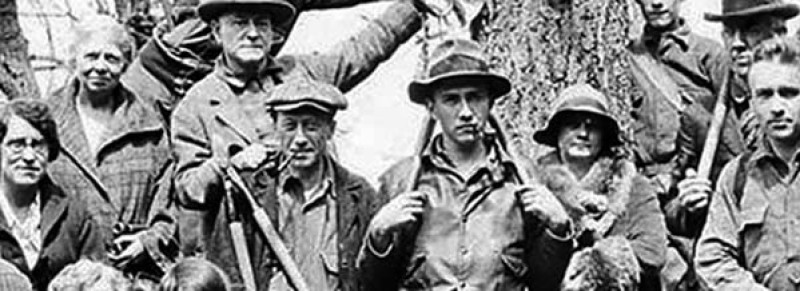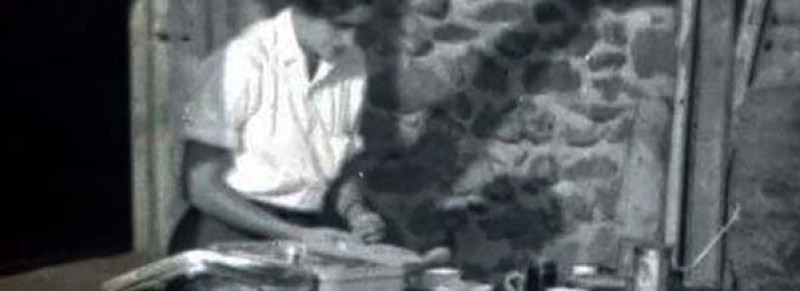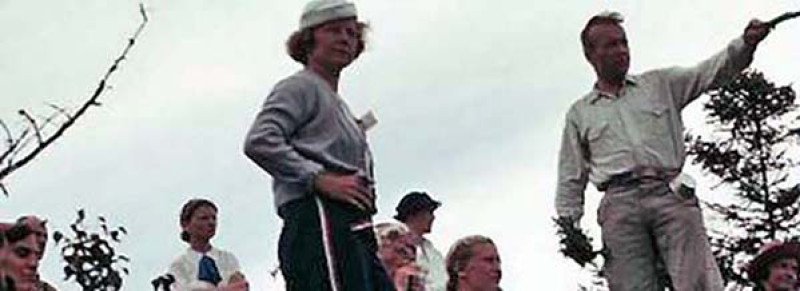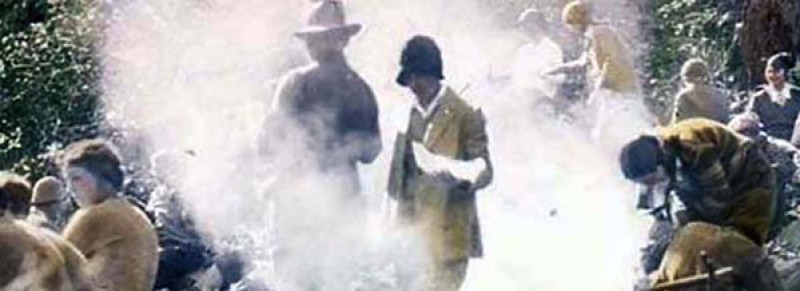A Short History of the PATC
by Carol Niedzialek
The idea of forming a trail club in Washington, D.C. was proposed by a group of members of the Wildflower Preservation Society. The group was comprised of eight persons—Myron H. Avery, Myron’s uncle Judge Joseph Cox, J. Frank Schairer, H. C. (Andy) Anderson, Dr. P. L. Ricker, Dr. L. F. Schmeckebier, Charlie Thomas, and Homer Corson.
This group often went on hiking/camping trips in the nearby mountains. In the 1920s there was talk among active outdoorsmen along the East Coast of having a continuous footpath on the mountain ridges between Maine and Georgia. In November of 1927, the group met in H. C. Anderson’s office to discuss what to call the trail. Frank Schairer held out for Blue Ridge Appalachian Trail Club; they compromised on Potomac since that is the region they expected to work in. Avery was chosen president and Schairer treasurer. After two years, the auditing committee reported that the “treasurer’s accounts are in order but he keeps no books.” To remedy the situation, Myron created a new office: Supervisor of Trails, and he gave the job to Frank. Marion Lapp (later a co-owner of Highacre) was selected for the treasurer’s job.
A few weeks before this meeting, Myron, his uncle, Andy and Frank took a bus to Paris, VA for a scouting trip to report on the situation and how hard it would be to cut a trail. Myron’s group, going south, had old wood roads so they said there would be nothing to it. Frank and his party, going north, had a terrible time finding their way. It took several months of weekend trips to get a trail cut. These people didn’t know anything about cutting trail so they learned as they went along. A few people from New England who had an interest in the trail project were available to help. A large part of the work was done by Myron, Frank, Andy and Charlie, all members of the Wildflower Society.
In 1928 it was difficult to get to the mountains—Virginia was unknown land except for Skyland. For most people, the workweek ended on Saturday noon, the dirt roads were terrible for driving, it was difficult to persuade people to do all that work for nothing, they said nobody would ever use the trails anyway. There were no such tools as clippers and weeders and they used mainly Boy Scout axes, later adding pruning shears. The goal the first year was to cut a trail from Bluemont to Harpers Ferry for the Red Triangle Hiking Club, a hike they scheduled once a year.
Between 1928 and 1932 with the help of the CCC, they constructed and marked about 260 miles of trail from the Susquehanna River to Rockfish Gap in Shenandoah Park. The Washington group led the way in helping the southern trail clubs get organized. In May 1930, the fourth ATC meeting—held at Skyland—was hosted by PATC and sparked a large attendance and widespread interest in the trail project for the entire length of the Appalachian chain. The trail across Maryland was completed by April 1932, and in Pennsylvania the same year.
Much of the early trail was on privately owned land with the consent of the owners. As hiking and backpacking activities increased, landowners started objecting to the many hikers and backpackers intruding on their privacy. Much of the trail was routed also through national and state forests and parks, so the trail was protected there.
Judge Perkins chaired the ATC since its beginning, but in 1930 he suffered an illness from which he never recovered. He requested Myron to carry on his work and in 1931, Avery was elected chair in Gatlinburg TN. He held the post for nearly a quarter century. The completion of the trail was due to Avery’s indefatigable efforts and example.
In the 1930s a lot of hiking/camping trips took place and were well attended. The February 22, 1930 holiday was the annual Old Rag Pilgrimage attended by 72 persons. By 1932, average trip attendance for the AT hike series was 70 people. Arrangement of private car trips this size became burdensome, so the use of buses became the norm. A system of long and short hikes on the same trip were part of the plan. The first edition of the Guide to Paths in the Blue Ridge was published in December 1931. Andy Anderson, in speaking to the Southern Virginia Trail Conference in 1932 said, “If hordes are thrown into a primeval environment, it soon disappears.” Regarding trail work, Benton MacKaye refers to Tom Sawyer having to paint Aunt Polly’s fence: “Work is what you are obliged to do. Play is what you are not obliged to do." An appropriate maxim for trail work. From the 1940s onward, the focus of trail work was maintenance, taking care of problem areas. Hiking trips both local and farther ranging became frequent, but the war years interrupted much of PATC’s activities. Between 1946 and 1948 a series of 20 continuation hikes took place starting at Rockfish Gap going to Susquehanna River, averaging 10 – 14 miles each.
1952 marked the end of an era. At the May ATC meeting, Avery reported that the trail was open from Maine to Georgia, improvements were being planned by the trail clubs, a chain of lean-tos (today called shelters) were being built by the trail clubs, and there were guidebooks with maps for the entire trail. Therefore, Avery declined re-election. The trail suffered a greater loss in July that year with the sudden death of Myron Avery. This was a setback of strong leadership of the club.
With the passage of the National Trail Systems Act by Congress in 1968, PATC became a partner of the National Park Service and worked closely with them on projects for the Appalachian Trail in PATC’s region, relocating trail off private land and onto forest and park land, and purchasing land for relocations of the trail. Tom Floyd and his crew put in much effort in getting trails off the road and back into the woods. Ruth Blackburn spent a great deal of time researching land ownership in Virginia.
Once the trail situation settled down, the PATC developed other necessary activities: the Trail Patrol, Leave No Trace, courses in trail maintenance, backpacking, and hike leadership became prominent activities. Social events also came to the fore: the pig roast, seafood festival. In the 1980s, the club had enough members in outlying areas to start five chapters; three special interest sections had been in existence for some time. At the present time PATC has eight trail crews that were developed to help overseers in times of emergency.
 South Shenandoah
South Shenandoah












